ASUS UL80Vt First Look: Mobility Redefined
by Jarred Walton on October 24, 2009 8:00 PM EST- Posted in
- Laptops
ASUS UL80Vt Benchmarked - General Performance
This is a first look and we have not yet had a chance to run all of our performance tests. Battery life testing in particular is going to take a long time -- which is a good thing, outside of the testing aspect. We have only had the UL80Vt for two days now, but we have been duly impressed with its features, design, and performance. It may not be the best-looking laptop on the planet, it may not have every feature under the sun, and it certainly isn't the fastest laptop. However, it does everything a typical laptop user could need, it does it at an affordable price point, and it truly manages to redefine what we can expect in terms of mobility from Windows laptops. Here are a few preliminary benchmarks we've run.
We conducted tests using the "moderate battery saving" and "maximum performance" profiles in ASUS' Power4Gear software. Turbo mode (overclocking) was enabled in all testing so far; honestly, we don't see much point in disabling it (which requires a reboot), but we'll test battery life without Turbo mode for the full review; that may add another 5-10% battery life, although the laptop already lasts a full day so it's not a critical concern. The SU7300 CPU has two P-states, 800MHz and 1300MHz; the overclocked FSB results in the SU7300 running at 1066MHz or 1733MHz (using a 4X or 6.5X multiplier). CPU-Z does not report clock speeds correctly (it always showed an 8X multiplier for some reason), but ASUS provided an updated version of Intel's Thermal Analysis Tool that reports the correct speed.
After a few initial tests, we discovered that the only way to get the CPU to run at the 6.5X multiplier is to select "Maximum Performance" in the Power4Gear software, with the maximum CPU speed set to at least 62%; otherwise the CPU will always run at the 4X multiplier. Since we already had a bunch of results for 1066MHz, we decided to report those -- it will make for an interesting comparison with the Intel Atom at least. The 1733MHz results will be in bright green and the 1066MHz results are in dark green in the following charts. We'll start with general performance results using PCMark as well as a few CPU intensive tasks like video encoding and 3D rendering.
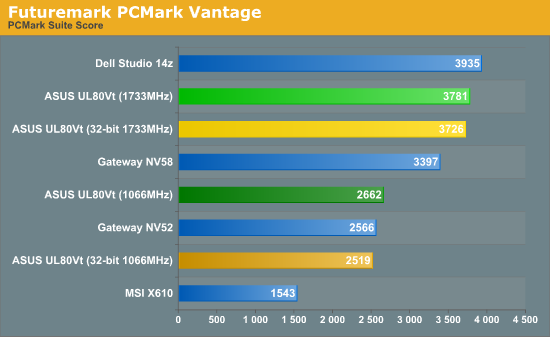
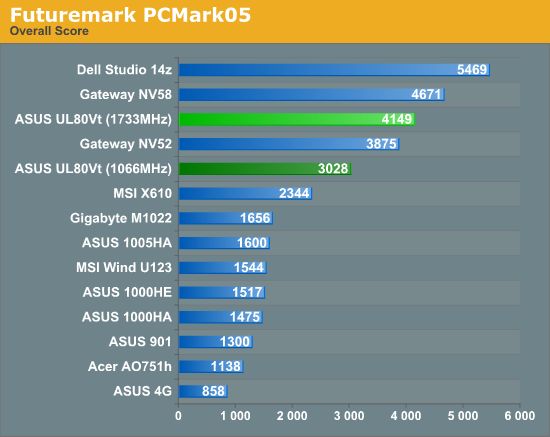
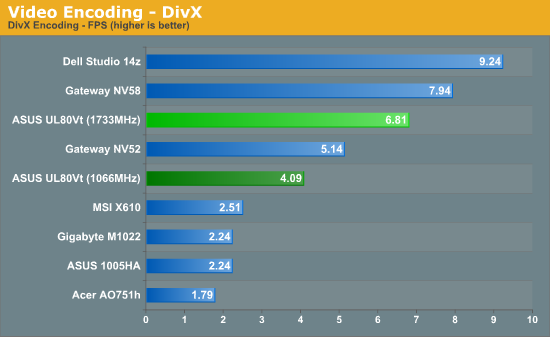

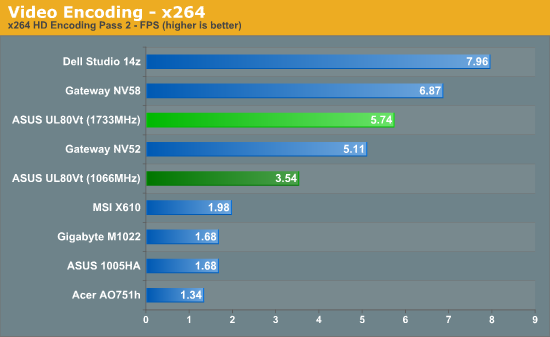
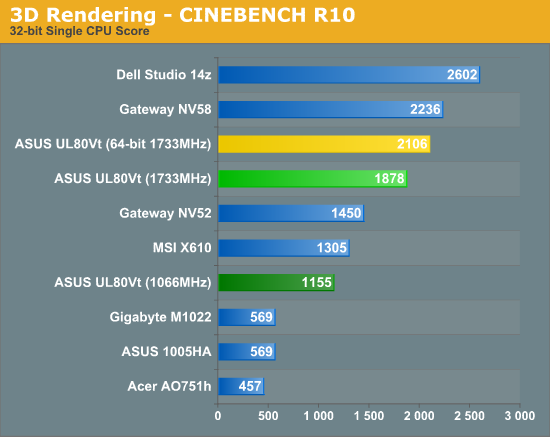
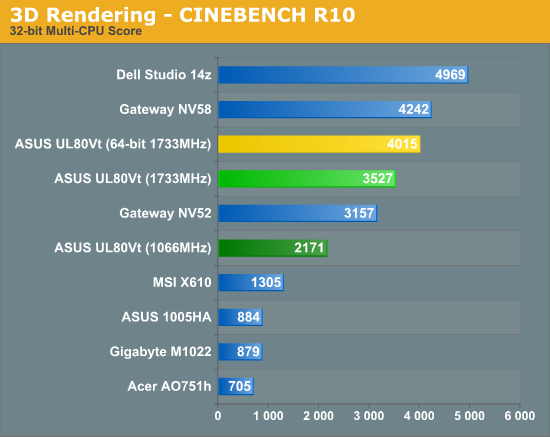
The general performance delivered by the UL80Vt is certainly impressive. It's not the fastest laptop on the market by any means, but application performance is better than the majority of AMD-based laptops currently available. The overclocked SU7300 outperforms the Athlon QL-64 (2.1GHz) by 7% in PCMark05, 47% in PCMark Vantage, 12% in the second x264 encoding pass (the first pass is relatively simple by comparison, depending more on the hard drive and platform than on the CPU), 32% in DivX encoding, and 12% in CINEBENCH R10. The latest 45nm AMD parts like the Turion II Ultra M640 will regain the lead, certainly, but we still have to account for power draw. We'll get to that in a moment, but suffice it to say that it's going to be difficult to beat the overclocked SU7300.
Comparing the UL80Vt to netbooks shows just how slow the Intel Atom is. Even at 1066MHz, the UL80Vt is typically at least twice as fast as the ASUS 1005HA, and at 1733MHz it's 150-250% faster. Sure, it also costs twice as much, but we would make a strong argument that netbooks are only "fast enough" if your demands are low. The bigger selling point for netbooks is their small size and weight, and 14" laptops costing close to $800 certainly encroach on that territory. Netbooks work far better as a second (or third…) PC than as your primary system, while something like the UL80Vt can fill all roles reasonably well. If the general application performance makes netbooks look bad, wait until we look at graphics performance.










100 Comments
View All Comments
JarredWalton - Friday, November 20, 2009 - link
The quick summary is:1) Excellent battery life
2) Good performance (i.e. CPU and discrete GPU are fast enough for most users)
3) Construction seems a bit weak (flex and such), but I don't think it's horrible.
For the overall package, I'm giving it a Bronze award - a better LCD and more rigid construction would be needed for Gold. For $800, though, I don't think you can find a better laptop right now.
juhaz - Wednesday, November 11, 2009 - link
I used to have Asus M6Ne, loved the thing, I was still happy with it despite the age. I originally bought it because it was one of the few laptops that had a decent SXGA+ display with reasonable price tag.That got stolen a while ago, so, I'm in a market for a new laptop. Asus, if you think I'm going to buy a new device that has 40% less resolution than the one I got from you FIVE YEARS ago, you better think again. Not going to happen. So, I'm going to get Stinkpad or Elitebook instead. If you would've had this with a nice WSXGA+ or WUXGA panel it'd been an instant sale, IPS would be nice but I can tolerate TN if it shows in the price.
I really hate it that display market only caters for the half-blind these days, on both desktop and laptop segments...
ippikiokami - Tuesday, November 10, 2009 - link
I would 100% pay more for a better screen! and a whole world of photographers would!Hrel - Sunday, November 8, 2009 - link
It had the SU9600 CPU instead and it had a decent screen.Resolution of at least 1600x900 and a contrast ratio of at least 500:1. I really don't understand why they don't just use the same screen as in the netbook.
I couldn't possibly agree more with your frustrations about crappy notebook monitors; I swear I'm not buying a new notebook till I can get one with over 5 hours battery life, a dedicated GPU, a resolution of at least 1600x900 and a decent color gamut and contrast ratio screen for less than a thousand bucks.
Gooberlx2 - Friday, November 6, 2009 - link
I'd like to see comments about the build quality. Notebookreview.com basically blasted the UL80vt for very poor build quality.I don't abuse my laptops but I don't treat them with kid gloves either. I'm interested in the UL series laptops, but can't really consider them if I don't think they'll keep together for longer than a couple years.
wfarid - Wednesday, November 4, 2009 - link
yea there are a LOT of people clamoring for just that. Switchable graphics, a high quality IPS MATTE lcd screen, and 10 hour battery life around 4.5lbs and you got me sold!Basically just take this laptop, pop a nice Matte Screen on there, change all that damn plastic gloss and replace it with aluminum or magnesium alloy (like that have in high end dslr's)
I think the HP Probook 5310 (I think) is a great and simple design. Just wish it had the guts of the Asus, with a better panel.
mobutu - Wednesday, October 28, 2009 - link
This laptop it's a step in the right direction-on the fly switchable graphics (i could go with even better that g210m);
-good battery life (especially for integrat chipset graphics);
-very good quality MATTE LCD screen (i would like to see IPS here and NO glossy) - at least make it optional for the people willing to go quality.
Hear that Asus? You better be.
I would buy such a machine, for sure.
Lukeh - Tuesday, November 3, 2009 - link
Well, actually I've been the proud owner of of Acer Travelmate 8371-G (business version of the Timeline) for a little less than 2 months now. And it does have discrete (switchable) 4330 graphics (though they could be stronger, but that's what my desktop is for), and i've had battery life last as long as 9 hours. Also, screen is matte. But, if this were out when I bought it, really it would all be about price.enki - Tuesday, October 27, 2009 - link
Now if only they had a multitouch tablet version of this. I really hope with the new multitouch support in 7 more laptops come out to take advantage of it.And an option for a better screen would be great, even if it was just a better TN screen that wasn't glossy
ProDigit - Tuesday, October 27, 2009 - link
I buy a netbook first and foremost because it's cheap.The majority of the people act like this.
When they see the $800 pricetag, to them it's nothing more than an underpowered laptop, and for that pricetag I can get myself a core2duo notebook that's a lot faster, with 2 extention batteries that will last me about as long!
Extension batteries are made very cheap these days!
Second, I buy a laptop because it is small in size, and light in weight.
Only third, because it has long battery life!
The good thing about this laptop is, that you can equip it with an SSD, and remove the ext. graphics card.
This will hopefully boost the battery even more!
I have an old core2duo 1,66Ghz laptop, with a GMA945Se graphics card or chipset or something, and can run most DX9 games (like WOW, Phantasy Star Unlimited, Prince of Persia, etc... at 1024x600 or 1024x768 resolution, 16 or 32 bit just fine.
Most sims I can play fullscreen at 1280x800.
I'm sure the faster processor, and better graphics card will make me be able to play WOW even better on this laptop.